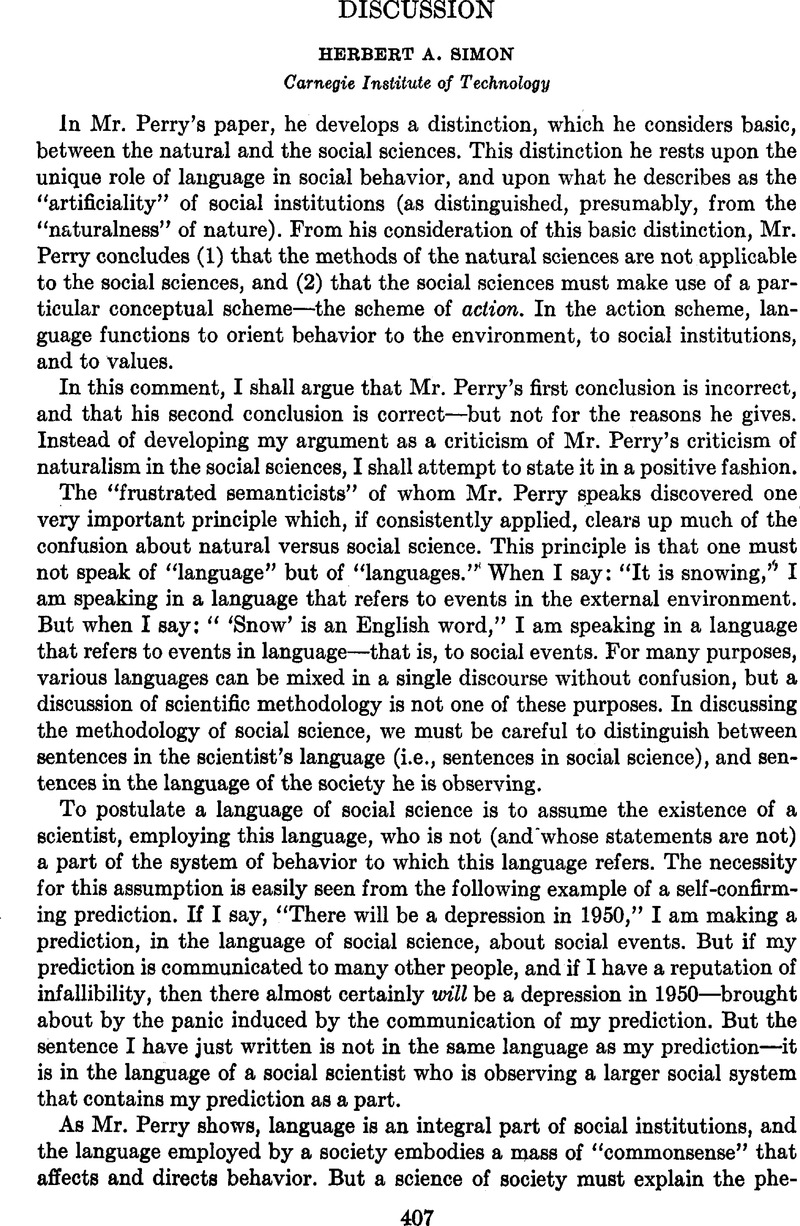Article contents
Discussion
Published online by Cambridge University Press: 02 September 2013
Abstract

- Type
- Discussion
- Information
- Copyright
- Copyright © American Political Science Association 1950
References
page 409 note 1 It should be noted that throughout this discussion the word “map” is a word in English, not in Martian.
1 Note on this subject the title as well as the content of the recent text by Carlson, A. J. and Johnson, V., The Machinery of the Body (3rd ed., Chicago, 1948)Google Scholar. See especially the section on mechanisms, pp. 4 and 5. The authors' illustrations of the fallacy of confusing (a) the evolution and utility of a system for (b) the machinery for bringing it about is wholly applicable to much writing in the social sciences. The appearance of such chapter headings as “The Decline of the Mechanistic View” (Einstein, A. and Infeld, L., Evolution of Physics [New York, 1938]Google Scholar, Ch. 2) in respectable physics books has misled many to the conclusion that we are returning to an orientation (e.g., vitalism) in vogue before the mechanistic view developed. A little further reading will soon convince anyone of the error of that assumption. The point is that field theory and relativity instead represent much more sophisticated “mechanical” views. The same may be said for the unwarranted glee with which some theologians greet Heisenberg's principle of indeterminism.
2 For a full statement of this position see my Foundations of Sociology (New York, 1939), Chs. 5 and 6Google ScholarPubMed. For a briefer and more recent statement see my paper before the AAAS, December 28, 1947, “Human Social Problems as a Type of Disequilibrium in a Biological Integration,” American Sociological Review, Vol. 13, pp. 689–699 (December, 1948)CrossRefGoogle Scholar.
3 See in this connection the opinion of a physicist, Whyte, Lancelot Law, “Scientific Thought in the Coming Ages,” Harper's Magazine, Vol. 197 (November, 1948)Google Scholar. “It is not possible to set out the evidence here, but there are many signs that the coming period may see the establishment of a single unified science covering the inorganic and organic realms and also providing the valid scientific approach to the subject matter of psychology and possibly also of sociology.” For illustrations, see Dodd, S. C., Dimensions of Society (New York, 1942), pp. 742–743 Google Scholar and Stewart, J. Q., “Empirical Mathematical Rules Concerning the Distribution and Equilibrium of Population,” The Geographical Review, Vol. 37, pp. 461–485 (1947)CrossRefGoogle Scholar; also, Zipf, G. K., Human Behavior and the Principle of Least Effort (Boston, 1949), esp. Part 2Google Scholar.
4 (New York, 1948).
5 See Science, Vol. 111, p. 500 (May 5, 1950)CrossRefGoogle ScholarPubMed.
6 (New York, 1947). See especially, Ch. 1.
7 I have dealt with that subjeet in a separate paper, “Alleged Obstacles to Social Science,” Scientific Monthly, Vol. 70, pp. 299–305 (May, 1950)Google Scholar. See also “Human Values—A Research Program,” forthcoming in Research Studies of the State College of Washington (September, 1950)Google ScholarPubMed. (Mimeographed copies available from author.)
8 “Some Views on Semantics in International Relations,” American Perspective, Vol. 2 (June, 1948)Google Scholar, reprinted in Etc.: A Review of General Semantics, Vol. 6 (Summer, 1949)Google Scholar.
9 Einstein, A., The Meaning of Relativity (Princeton, 1945), p. 2 Google Scholar.
- 6
- Cited by





Comments
No Comments have been published for this article.